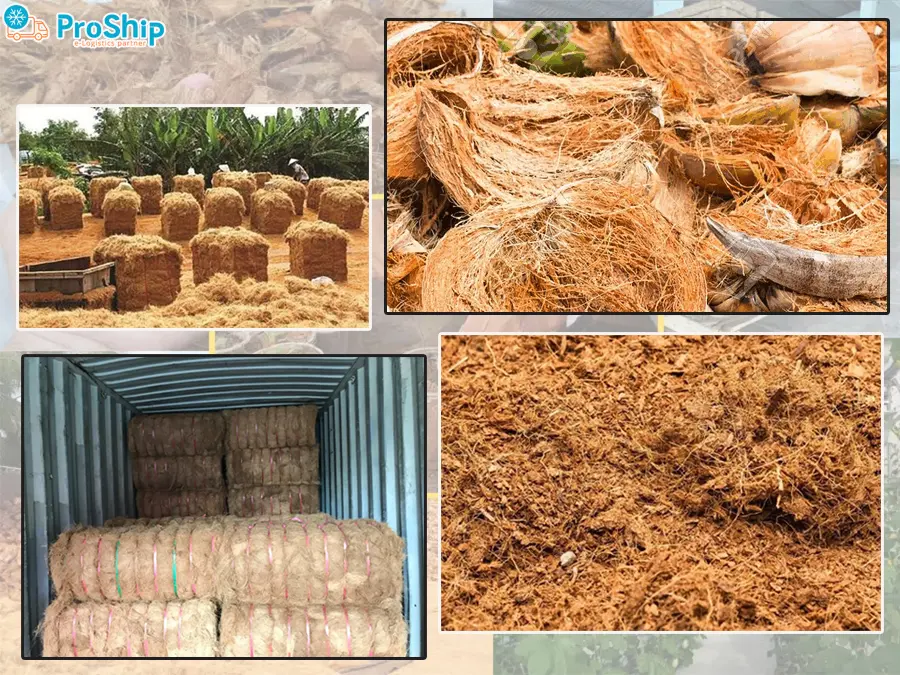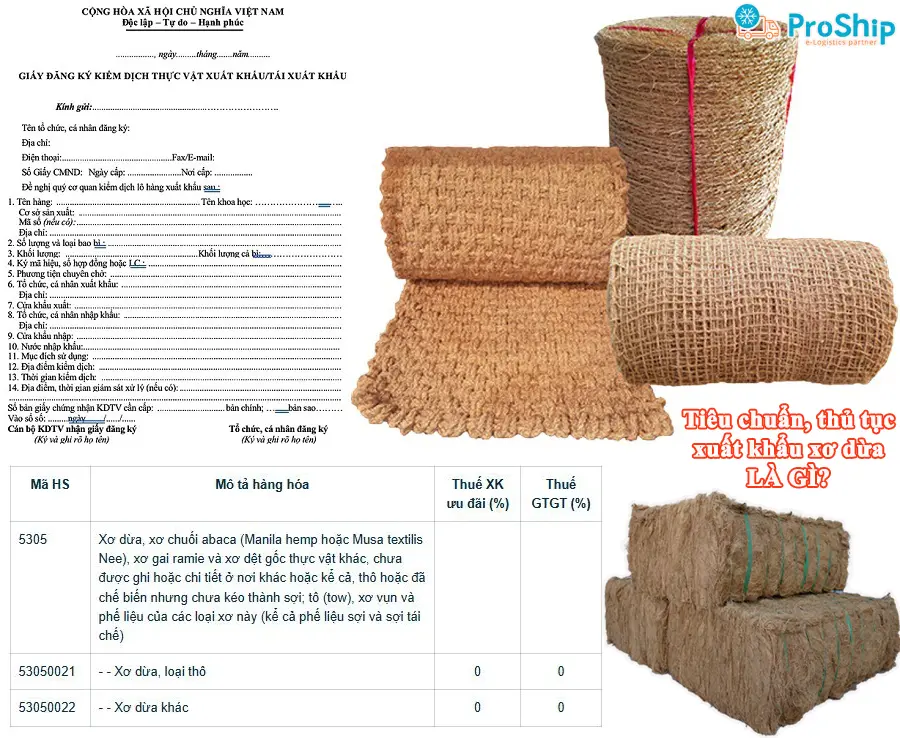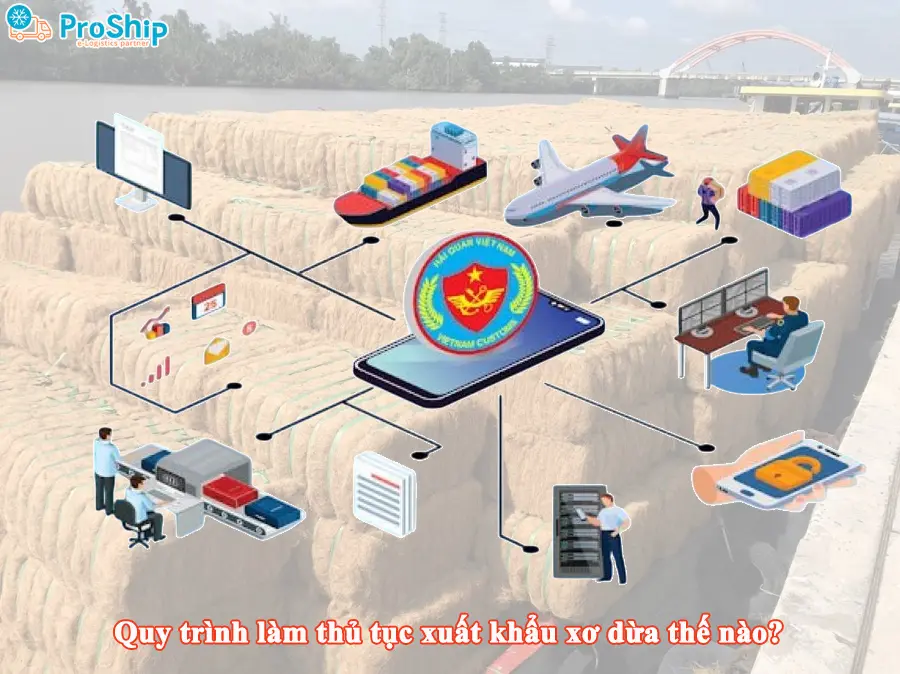x Do you need to update the recent situation of Vietnam's coir fiber exports? Are there any positive signs?
x Are businesses, factories, households selling products from coconut fiber in the provinces of Ben Tre, Tien Giang, Tra Vinh, Vinh Long, etc. needing to expand their consumption market for coconut fiber to other countries? x Does your export unit not have much experience in preparing relevant documents, plant quarantine certificates, customs procedures, etc. for coir products?
at Proship.vn are currently one of the professional Forwarders, leading in the transportation of fresh coconuts, bald coconuts, etc., and will update new information for businesses, gardeners, and business households to clearly understand the standards and regulations. Procedures for exporting Vietnamese coir to other countries. At the same time, it also introduces an overview of the potential and situation of Vietnam's coir export in recent times.
What is the current situation of coconut fiber export?
Coconut trees have brought many practical benefits to human life from ancient times to the present. Coconut trees not only provide shade, but coconut leaves are also used to make hats. Coconuts provide cool drinking water. In particular, after being recycled, coconut shells will produce coconut fiber - a popular material in handicraft industries such as making coconut fiber mats, and is also widely used in agriculture.
Previously, coconut fiber was considered scrap and had no economic value. But now this item is very popular in Vietnam. Ben Tre is the province with the largest coconut growing area in the country, with more than 72,000 hectares and an output exceeding 600 million coconuts per year.

According to the Department of Industry and Trade of Ben Tre province, coconut fiber is currently one of the province's key export products. In 2019, Ben Tre exported nearly 49,000 tons of coconut fiber, this number in 2020 was nearly 45,000 tons. In 2021 alone, due to the impact of the Covid-19 pandemic, the province can only export about 30,000 tons of coconut fiber.
Vietnam's key coir export markets include Europe, Japan, Australia, Korea, the Middle East and many other regions. To export coir to these markets, exporters must comply with necessary export procedures.
Standard conditions and procedures for exporting coconut fiber
Proship updates standards and procedures for exporting coconut fiber so that businesses and business households can clearly understand:
HS code and export tax of coir fiber
According to the 2024 Import-Export Tariff, coconut fiber and products from coconut fiber are classified in Part II, Chapter 53, group 05. Below are the HS Codes of coconut fiber and some products from coconut fiber:
|
HS code |
Description of goods |
Preferential export tax (%) |
VAT (%) |
|
5305 |
Coconut fibre, abaca (Manila hemp or Musa textilis Nee), ramie and other vegetable textile fibres, not elsewhere specified or included, raw or processed but not spun; tow, noils and waste of these fibers (including yarn waste and garnetted stock) |
||
|
53050021 |
– – Coconut fiber, raw |
0 |
0 |
|
53050022 |
– – Other coconut fiber |
0 |
0
|
Legal policy
Coconut fiber DOES NOT BELONG to the List of goods banned from import and export. Therefore, units and businesses can carry out customs procedures to export coir fiber like normal goods.
Customs documents for exporting coconut fiber
Customs dossiers for exporting coir fiber include the following papers and documents:
- Commercial Contract (Sales Contract);
- Commercial Invoice;
- Packing list;
- Certificate of origin (C/O) (if any);
- Plant quarantine certificate (Phytosanitary);
- Other documents required by the importing country and customs authorities.

In addition, the set of documents to obtain a certificate of fumigation of coconut fiber products includes:
- Commercial Invoice (Commercial Invoice);
- Packing list (Goods packing slip);
- Commercial contract;
- Bill of lading (Sea bill of lading.
* Note: Time to issue the certificate is 1-2 days (from spraying the container and submitting all the above documents).
Regulations on coconut fiber labeling
Information must be clearly stated on the packaging and labels of coir and coir products, including the following important details (in English and the language of the exporting or importing country):
- Name of manufacturing enterprise;
- Production date and expiration date of coconut fiber;
- Origin;
- Product ingredients (if any);
- Other related information.
Procedures for exporting coconut fiber
Below is the procedure for carrying out export procedures for coconut fiber:
Step 1: Prepare customs documents
Prepare complete documents as required by customs, including relevant documents and documents mentioned above.
Step 2: Register for customs declaration
Register KBHQ for exported coconut fiber products at:
- At the Customs Branch where the enterprise is headquartered or production facility;
- At the Customs Branch where goods are gathered for export;
- At the Border Gate Customs Branch where the goods will be exported
Step 3: Check the customs declaration
The inspection of customs declarations is prescribed as follows:
- If the product/shipment does not meet the conditions, the customs authority will refuse to register the customs declaration and provide the reason to the custodian;
- If declaring on a paper customs declaration, customs officials are responsible for carefully checking the registration conditions in the declaration and other documents in the customs dossier.

Step 4: Stream the declaration
With electronic customs declarations, the decision on classifying declarations and notifications is made by the Director General of the General Department of Customs on the electronic customs data processing system in one of the following forms:
- Accept customs declaration information (Green channel):
Customs declarations are accepted without requiring further information or inspection except under normal conditions.
- Check relevant documents in customs records (Yellow channel):
Documents related to customs records, submitted or presented by customs declarants, will be examined in detail and exempt from detailed inspection of goods. If no further violations are detected, the customs clearance process moves to step 5, similar to Green Channel.
- Physical inspection of goods based on document inspection (Red channel):
The process of physical inspection of goods is carried out based on checking relevant documents in customs records, submitted or presented by the customs declarant on the customs system. This helps organizations manage and process information related to electronic customs declarations effectively, comply with procedures and ensure data accuracy.
Step 5: Customs clearance of goods
After checking the documents and goods, if no problems arise, the customs officer will accept the customs declaration.
We at Proship Logistics have promptly updated coir export standards with the process of customs procedures according to the latest regulations for private individuals and businesses to refer to and apply... When in need, contact us. Call 0909 344 247 for advice and quotes. Coconut shipping service to China and other countries with full customs declaration at the cheapest price.
